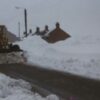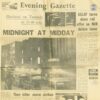A summary of Winter 1946-47 – Brutal February
Whilst Winter 1962-63 is regarded as the longest winter, Winter 1946-47 is perhaps remembered as the snowiest. The winters were very different however.

January 1947.
Cold (2.2C CET), but not excessively so overall. The month is most memorable for the start of a severe, prolonged, and exceptionally snowy cold spell. Although there had been some significant snowfalls in December, and again on the 4-5th, the harsh winter did not really get going until the third week, after quite a mild interlude (hence the average). After some early cold snaps, there was a very pleasant, mild interlude. The first five days were mild and wet, with a heavy snow fall early on the 6th and snow lying on the ground until the 9th. It then turned very mild with westerly winds from the 14th to 18th.
Very Mild mid-month, and then …..
It reached 14C in places on the 16th; Saturday 18 January was sunny and mild, and then … The severe winter really started on the 20th January, with the first frost since the 7th. On the 22nd, a NE airflow brought cold air all the way from Siberia. There were frequent snow showers on the 22nd and 23rd. On the 26th much of England experienced continual frost. There was a major blizzard in the southwest on the 28th. There was a minimum of -21C early on the 29th at Writtle (Essex), and then a maximum of -5C over much of eastern England. There was 17cms of snow on the Isles of Scilly on the 30th.
February 1947.
The coldest February ever recorded (-1.9C CET), the second coldest month of the century (after January 1963), and the coldest month overall since January 1814. Many places in England were beneath freezing from the 11th to the 23rd; Greenwich registered 14 consecutive days beneath zero. At Oxford frost began at 6 pm on the 10th and continued until 6 am on the 26th. The record low average was mainly determined by the very low maxima. Low minima were not outstanding because of the extensive cloud cover, until clearer skies at the end of the month, when -21C was recorded at Wolburn on the 25th.
Persistent Easterlies bring lots of snow
It was a persistent easterly month of the sort that weather people long for: large amounts of snow in the east (e.g. 1.35 m of snow lay at Forrest-in-Teesdale (Durham) on the 18th. It was also very dull. There was no sunshine at all at Kew Observatory from the 2nd-22nd inclusive, and only 17 hours of sunshine in total for the month (compared with the average of 61). A side-effect of the Easterlies was that the Scottish Highlands had no rain at all this month, for the first time in recorded history, where it was also very sunny.
It was, of course, also snowy, with snowstorms particularly affecting the south, midlands, and east. There was a major snowstorm on the 25-26th. It was also quite a windy month. Buxton in Derbyshire had 30 consecutive days of frost. At Kew the maximum temperature of the month was 5C. Hence I vote this to be the most interesting February of the century.
March 1947.
The severe winter continued into the first half of the month. There were some very low temperatures -21.1C at Houghall, Durham, Peebles, and Braemar, on the 4th; widespread flooding after a rapid thaw of the famous winter; ice storms, blizzards, heavy rainfall, and on average the wettest March on record (177mm , which was 300% of average).
Heavy snowfall over England and Wales on the 4th and 5th, including several cms in the London area, caused more disruption. There were more readings of -20C on the 8th, including -21.1C at Braemar. Much of the country was covered in snow for the first part of the month, with drifts up to 5m deep on the Pennines, and even up to 3m deep at Whipsnade on the 9th.
The thaw starts, with floods
Warm air and heavy rain started to move in on the 10th March. This led at first to a great snowstorm in Scotland on the 12-13th. 52mph wind was recorded at Mildenhall, and a mean windspeed of 44mph at Edgbaston, both in a severe SW gale on the 16th that affected south Wales and the south of England in one of the worst March storms of recent times.
Flooding was particularly severe in the east, particularly the Fen country. More heavy sleet in Sussex on the 28th March, as temperatures fell again at the end of the month. It was the coldest month of the century in Scotland, and the wettest of the century in England and Wales (177.5 mm, 292% – the highest percentage, too).
Clearly this must be the most interesting March for weather of the century!
https://www.trevorharley.com/weather_web_pages/britweather.htm

Sponsor us and have your logo displayed here, on every post or page. We'll link to your website too.












